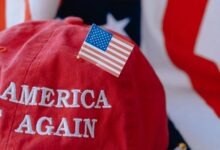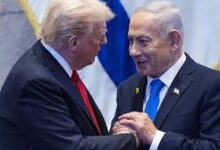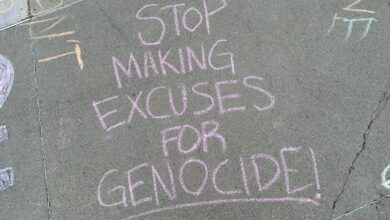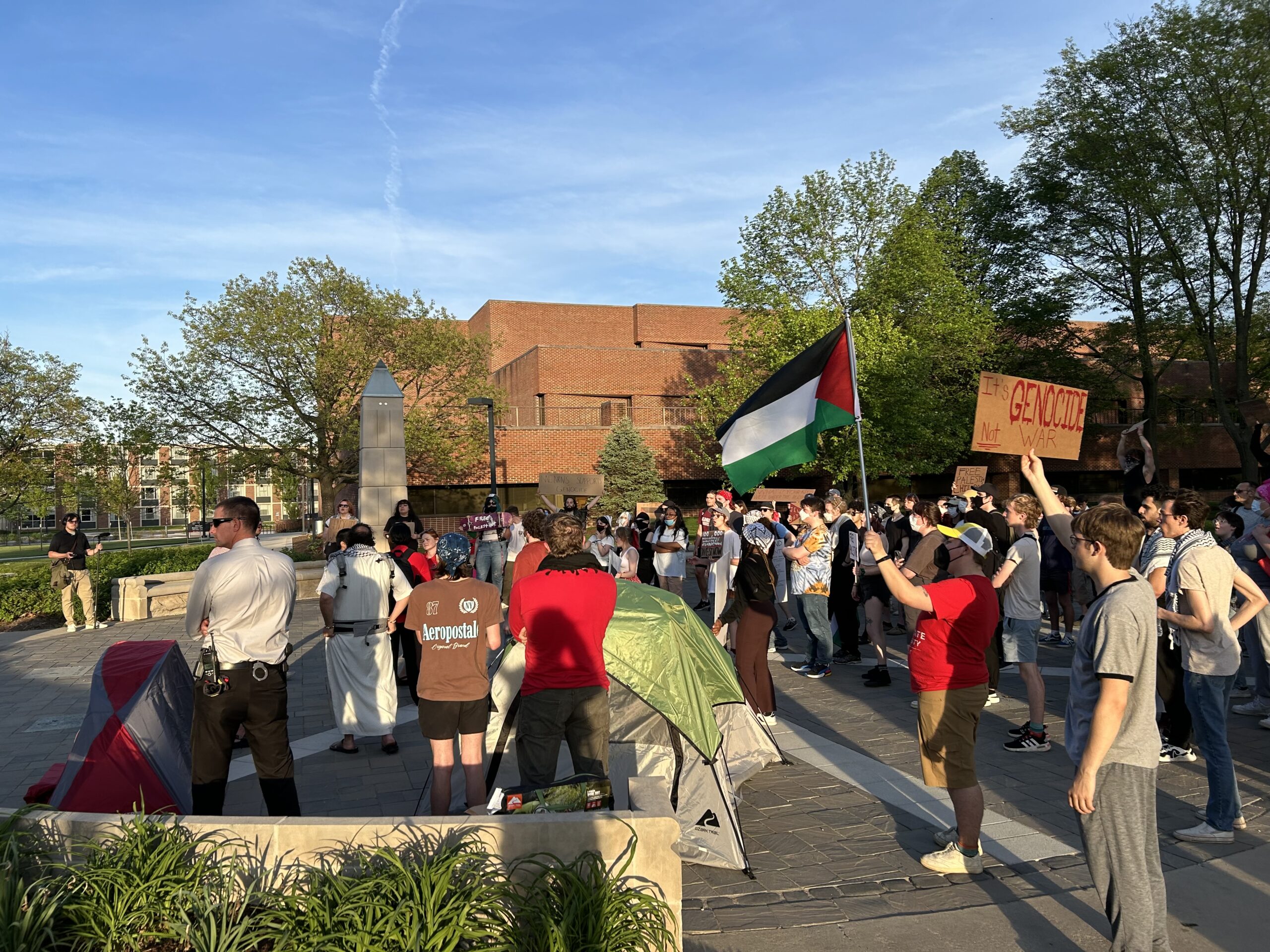
On May 1st, 2024 , shortly before the fifty-fifth anniversary of National Guardsmen shooting students at Kent State University, almost 200 protesters assembled for a peaceful encampment at Ball State’s ‘frog baby’ statue between the Bracken Library and The Peace Plaza. These individuals were protesting Israel’s invasion of the Gaza Strip and the Ball State endowment, which is partially invested in companies who support or have some investments in Israel.
Activist movements have strived to keep Palestine’s freedom as its own nation since the late nineteenth century, when the Zionist Movement began immigrating Jewish citizens into Ottoman controlled Palestine. Since the October seventh Hamas attacks in 2023, the ongoing Israel-Palestine conflict has moved to the front headlines, spurring social movements as an increasing number of activists sought to express their views regarding Palestine’s freedom. Our nation has seen events like this in the past, with protests against the Vietnam war, the Iraq war, and other causes throughout America’s history.
Starting at four p.m., demonstrators near the frog baby statue began chanting, speaking out against Israel’s actions and calling attention to potential Ball State complacency. Activists held signs with phrases like, ‘How would you feel if it was your kid under the rubble?,’ ‘It’s Genocide Not War,’ and ‘If you went to 1 funeral per day for each child killed in Gaza, it would take over 37 years.’ Protesters also chanted slogans like, “Israel bombs, Ball State pays, How many kids did you kill today?,” “Not another nickel, not another dime, no more money to Israel’s crimes,” and “Disclose, divest, we will not stop, we will not rest.”
The Ball State University President, Geoffrey S. Mearns, was present for a portion of the protest while the student activists chanted, “Mearns, Mearns, you can’t hide, you’re supporting genocide.” Mearns did not interact, but watched from the sidelines for about twenty minutes before leaving. Unlike Mearns, some passers-by shouted statements like “Go Israel!” and attempted to aggravate students. Throughout the demonstration there was a constant police presence. When questioned, Ball State administration claimed the police were ‘required’ to be present for safety reasons, to which some rebutted that police were not present at the smaller Zionist protests.. Some criticized the police personnel for wearing plain clothes instead of a uniform while still wearing their guns.
The chants eventually slowed, as one demonstrator gathered everyone’s attention and began to speak on Israel’s actions. The speaker, a black Jewish woman, detailed how “[Israel] received maximum help, support, and encouragement from Great Britain, the United States, and other white western colonial governments.” Some speakers also gave presentations on certain Israel-led atrocities occurring in Palestine, including an incident in which a young boy was forced to drink gasoline and then immolated, as well as some of the families struggling to flee the Gaza Strip. It was also mentioned in this presentation that Palestinians had brought their house keys with them during early evacuations because they thought they would be returning soon. Months later, these keys stand as a symbol of hope for all of the Palestinians that are far from their homes. Another symbol among Palestinians is the olive tree, a symbol of Palestinian resilience, trees which Israeli soldiers have been burning as a way to lower Palestine morale. As the presentations finished, protesters began unpacking chalk, and marked the sidewalk with pro-Palestine phrases, including ‘Stop making excuses for genocide!’ When the protesters finished, Joseph Souza, one of the event’s organizers, rushed out and shouted that a fellow activist was surrounded by police and administration.
Activists followed to the Peace Plaza, where two students had set up tents in order to stay the night. They were surrounded by both police and Ball State administration, including Vice President of Student Affairs, Ro Anne Royer Engle. The two students negotiated with Engle as two police officers stood uncomfortably close behind them. Protesters quickly filed into the Peace Plaza and began chanting, “Who’s campus? Our campus!” The students made sure to remind everyone that their money is what keeps Ball State afloat, and with no students there would be no campus. The protesters remained dissatisfied with the nature of the police presence during the talk with Engle.
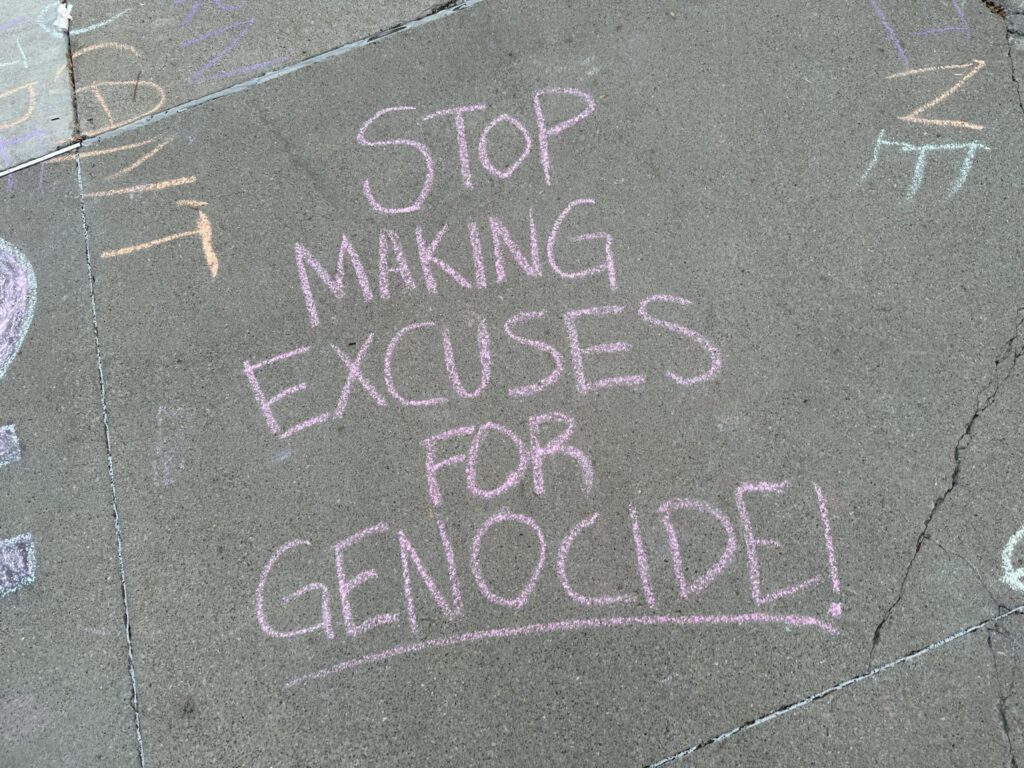
Every so often during the chants, a speaker would come forward with a speech for both other activists and the administration. One notable speech was from a Burris Laboratory School student: the student mentioned that Burris is a lab school because it is about teaching new ideas in innovative ways and that some of Burris’s funding is from Ball State. He questioned: how can Ball State support a lab school- which encourages innovative ideas- yet shut down student protests. Another individual, a Ball State student, claimed that he attended Ball State because he was told it was a “good school for journalism,” yet he is now feeling less confident, questioning as to “how a school for journalism can support Israel, who has killed more journalists than any other war in history?” An important figure was Ziad Jaber, a Palestinian man who had previously lived in Palestine and lived through the damage done by Israel. He reassured protesters that despite not having seen Palestine firsthand, and being told by some they had no idea what was actually happening, they were fighting for the right thing.
Joseph Souza spoke with Engle, negotiating for the students to keep their tents up. He cited the fact that Ball State allows hammocks to be set up overnight, and asked why a tent would be any different. To this, Engle responded, “a hammock is a hammock and a tent is a tent,” refusing to elaborate any further. After hours of speeches, chants, negotiations, and a direct calling out of administrators, the Ball State Administration eventually conceded and allowed the protesters to keep two tents up but nothing more.
Some protesters participated in interviews during times without active chants. Here is what they had to say:
Joseph Souza, one of the main organizers of the encampment, is a Junior Political Science Major at Ball State University. Joseph Souza says that students should be involved in events like these protests because, “their voice is so powerful.” When asked to comment on the actions we’ve seen at other college campuses, Souza states, “I think incredibly heroic. Heroic and bold.” Souza commends students at colleges like Columbia for their courage. Joseph Souza comments that “small measures like here of civil disobedience show that we are not complicit, we are in fact horrified and disgusted, and we are moved to do something, we are moved to disobey.” Joseph adds that the police presence at Ball State and brutality at other colleges is “a horrifying, yet shockingly expected trend,” and follows up with “police violence has been clearly on the rise, has been concentrating, has been polarizing.” He comments on projects like ‘Cop City,’ where police are being taught counterinsurgency measures, and claims that to protesters, “counterinsurgency is what happens when police come to remove us and brutally terrorize activists and other organizers.” To wrap up the interview, Souza (on the power of students) said, “if you want to know how powerful something is, look at the opposition towards it.” He comments that students have been facing brutal police responses, and are directly opposing some of the actions of the US government. Joseph jokes that at Ball State, “we have the privilege of not being brutalized yet,” and then states, “you look at the forces that we’re up against and you cannot be afraid. You cannot blink, you cannot hesitate.”
Buffy, a Ball State Junior studying to earn their Bachelor’s, claims that, “young people are the future. Young people create the change.” Buffy references Sham 69, an English punk rock band, giving agreement to their quote, “when the kids are united, they can never be divided.” Buffy claims that “when we organize and we get together we are ten times stronger.” Buffy comments on the police responses, saying “I believe that cops follow a system and that system is oppression,” following with stating that the earliest days of police were slave patrols. Buffy claims police are “here to be guard dogs of the rich… …and to protect property.”
Lidya is a Muncie community school history teacher and Ball State graduate. She claims that, “historically students have stood up and have spoken out for protests, their voices have been consistently squashed.” Lidya says she finds it “incredibly daunting” to grow up in the same world she hoped had changed. Lidya says “our generation especially has grown up being told, ‘no, we can’t take away guns, but we can teach you how to survive in a shooting,’” and commends students at other universities for “taking the same tactics that the government pushed on us to use, against an oppressive police state.” She comments on the police response at Ball State especially, claiming “Ball State kept saying, ‘we don’t want to be like IU, we don’t want to be like these other college campuses.” She claims that the police being present at all, and especially in plain clothing with weapons, “is a very clear stance that yes they are okay with being just like IU.” Lidya ends the interview saying, “the fact that they keep trying to remove encampments and tell us how to protest is laughable.”
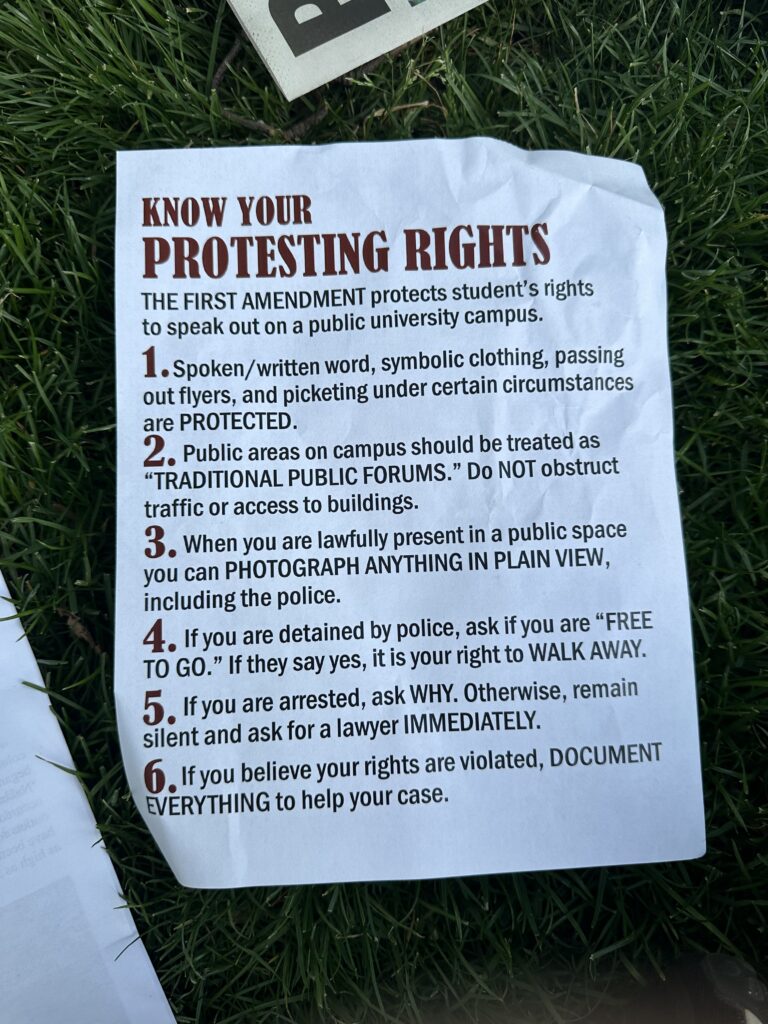
Ziad Jaber is a Biotechnician by education, but is currently working as a direct support professional for individuals with developmental disabilities. Ziad encourages students, saying, “these students are carrying on the legacy of the deceased, the legacy of [Palestinians] who have no voice now because they’re six feet under or burned alive.” Ziad finds it appalling that, “protesters that have been demonstrating peacefully” received police response “instigating a physical or a violent reaction from these people or simply the police committing violence themselves.” Ziad says, “it’s unacceptable, because it goes against what it means to be an American.” Ziad claims to have had ‘jitters’ throughout the protest, and is present with his seven month old daughter. He states, ‘I can’t think I would stay quiet because I was nervous when there are people who are facing the death of these children.”
As the hour approached ten o’clock, the police presence began dissipating, allegedly due to fatigue, at least according to eyewitness accounts. Such a voluntary leaving suggests that the police presence was not in fact ‘required.’ Demonstrators claimed in the following days that they rarely saw police, about once every twelve to fourteen hours, and only for forty-five minutes at a time. One especially noticeable incident was that of a police officer hiding under the Ball State Bell Tower. The event seemed a piece of cosmic irony, as protesters discussed the 1966 Texas Bell Tower Shooting, in which an ex marine hid in the University of Texas Bell Tower and shot multiple civilians. They discussed its similarities to current events, as a militarized person hid under the BSU Bell Tower, peeking out from the walls as if afraid of the college students gathered in the Peace Plaza.
The encampment continued over several days, concluding on May fourth, the exact anniversary of the Kent State Shooting. It was also the day of Ball State’s Commencement, and a small group of remaining activists visited the ceremony, and stood silently on the outskirts holding their signs. As the attendees dispersed, the demonstrators received mixed responses. Some newly graduated students offered to take graduation photos with the signs to post on social media, but others passing by accused the group of being antisemitic, ironically yelling at some Jewish students.
After the ceremony, the group returned to the Peace Plaza where they had camped for a few nights, and held their signs once more. Ziad Jaber offered a chance to make dialogue about Palestine and Israel, offering to educate anyone who was interested. Ziad also created one last symbolic demonstration, putting up a tent in the Peace Plaza, with a sign urging anyone to ‘sleep like 2.4 million Gazans’ for one night. He described to protesters that although it was a mere fraction of the pain suffered by millions in Gaza, he hoped the demonstration would create empathy for the Gazan people.
Authors:
Bryn Pfanschmidt is a recently graduated high school senior ready to start college at Indiana University. She primarily writes for the yearbook and enjoys creative writing in her free time.
Jordan Heaviland attends a high school in Delaware county. He is published in literary journals like Perspicacity, and he primarily writes poetry but enjoys writing longer pieces as well.

